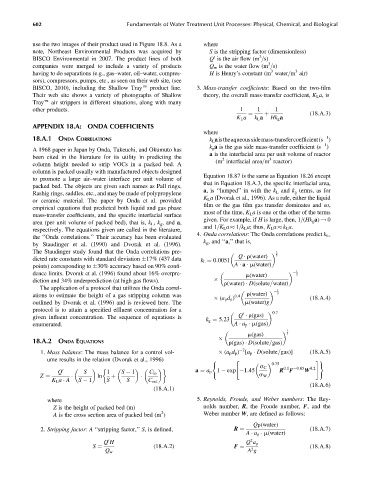Page 647 - Fundamentals of Water Treatment Unit Processes : Physical, Chemical, and Biological
P. 647
602 Fundamentals of Water Treatment Unit Processes: Physical, Chemical, and Biological
use the two images of their product used in Figure 18.8. As a where
note, Northeast Environmental Products was acquired by S is the stripping factor (dimensionless)
3
BISCO Environmental in 2007. The product lines of both Q is the air flow (m =s)
0
3
companies were merged to include a variety of products Q w is the water flow (m =s)
3
3
having to do separations (e.g., gas–water, oil–water, compres- H is Henry’s constant (m water=m air)
sors), compressors, pumps, etc., as seen on their web site, (see
BISCO, 2010), including the Shallow Traye product line. 3. Mass-transfer coefficients: Based on the two-film
Their web site shows a variety of photographs of Shallow theory, the overall mass-transfer coefficient, K L a,is
Traye air strippers in different situations, along with many
other products. 1 1 1
(18:A:3)
K L a k L a Hk g a
þ
¼
APPENDIX 18.A: ONDA COEFFICIENTS
where
1
18.A.1 ONDA CORRELATIONS k L aistheaqueoussidemass-transfercoefficient(s )
1
k g a is the gas side mass-transfer coefficient (s )
A 1968 paper in Japan by Onda, Takeuchi, and Okumuto has
a is the interfacial area per unit volume of reactor
been cited in the literature for its utility in predicting the 2 3
(m interfacial area=m reactor)
column height needed to strip VOCs in a packed bed. A
column is packed usually with manufactured objects designed
Equation 18.87 is the same as Equation 18.26 except
to promote a large air–water interface per unit volume of
that in Equation 18.A.3, the specific interfacial area,
packed bed. The objects are given such names as Pall rings,
a,is ‘‘lumped’’ in with the k L and k g terms, as for
Rashig rings, saddles, etc., and may be made of polypropylene
K L a (Dvorak et al., 1996). As a rule, either the liquid
or ceramic material. The paper by Onda et al. provided
film or the gas film gas transfer dominates and so,
empirical equations that predicted both liquid and gas phase
most of the time, K L a is one or the other of the terms
mass-transfer coefficients, and the specific interfacial surface
given. For example, if H is large, then, 1=(Hk g a) ! 0
area (per unit volume of packed bed), that is, k L , k g , and a,
and 1=K L a 1=k L a; thus, K L a k L a.
respectively. The equations given are called in the literature,
4. Onda correlations: The Onda correlations predict k L ,
the ‘‘Onda correlations.’’ Their accuracy has been evaluated
k g ,and ‘‘a,’’ that is,
by Staudinger et al. (1990) and Dvorak et al. (1996).
The Staudinger study found that the Onda correlations pre- 2
Q r(water) 3
dicted rate constants with standard deviation 17% (437 data k L ¼ 0:0051
points) corresponding to 30% accuracy based on 90% confi- A a m(water)
1
dence limits. Dvorak et al. (1996) found about 16% overpre- m(water) 2
diction and 34% underprediction (at high gas flows).
r(water) D(solute=water)
The application of a protocol that utilizes the Onda correl-
1
ations to estimate the height of a gas stripping column was 0:4 r(water) 3
(a p d p ) (18:A:4)
outlined by Dvorak et al. (1996) and is reviewed here. The m(water)g
protocol is to attain a specified effluent concentration for a
0:7
0
given influent concentration. The sequence of equations is Q r(gas)
k g ¼ 5:23
enumerated. A a p m(gas)
1
m(gas) 3
18.A.2 ONDA EQUATIONS r(gas) D(solute=gas)
2
1. Mass balance: The mass balance for a control vol- (a p d p ) [a p D(solute=gas)] (18:A:5)
ume results in the relation (Dvorak et al., 1996) ( " #)
0:75
s C
0:1
R F 0:05 W 0:2
Q 0 S 1 S 1 C in a ¼ a p 1 exp 1:45
ln s W
K L a A S 1 S S C out
Z ¼ þ
(18:A:6)
(18:A:1)
where 5. Reynolds, Froude, and Weber numbers: The Rey-
Z is the height of packed bed (m) nolds number, R, the Froude number, F, and the
2
A is the cross section area of packed bed (m ) Weber number W, are defined as follows:
Qr(water)
2. Stripping factor: A ‘‘stripping factor,’’ S,isdefined, R ¼ (18:A:7)
A a p m(water)
2
Q H Q a p
0
(18:A:2) (18:A:8)
S ¼ F ¼ 2
Q w A g

